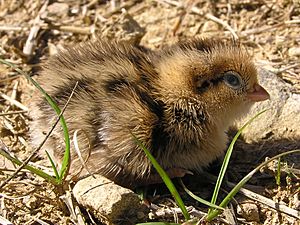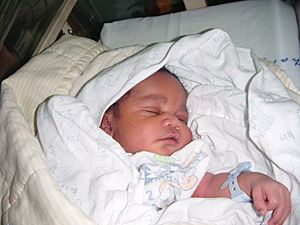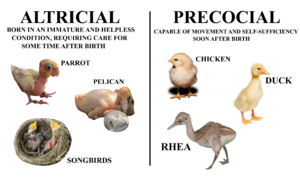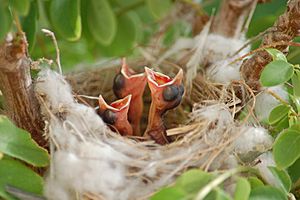Precociality and altriciality facts for kids
In the world of animals, especially birds and mammals, babies are born in different ways. Some are born very helpless, while others are ready to move around almost right away! We call these two main types altricial and precocial.
Altricial species have babies that are not very developed when they are born or hatch. They need a lot of help from their parents to grow up. Precocial species have babies that are much more developed. They can move and do things on their own very soon after birth or hatching. Often, precocial babies leave their nest or birthplace quickly. It's important to know that animals don't fit perfectly into just one of these groups. It's more like a sliding scale!
For fish, these terms can also describe if a baby fish has a stomach when it starts eating. Precocial fish larvae have a stomach, but altricial fish larvae do not.

Contents
Altricial Animals
Altricial animals are born or hatched in a very helpless state. They are often born with their eyes closed and without much hair or down. They cannot find their own food or move around much. Because of this, their parents must care for them for a long time.
What "Altricial" Means
The word "altricial" comes from a Latin word, alere. This word means "to nurse," "to raise," or "to feed." This name fits perfectly because altricial babies need a lot of feeding and care for a long time.
Examples of Altricial Animals
Many well-known animals are altricial. For example, human babies are altricial. They need years of care from their parents. Other altricial mammals include domestic cats, dogs, and most rodents. When a kitten is born, it cannot see, hear, or even keep its own body warm!
Many birds are also altricial. These include herons, hawks, woodpeckers, owls, and most passerines (songbirds). Their chicks hatch naked and blind, needing constant warmth and food from their parents.

Precocial Animals
Precocial animals are born or hatched much more developed than altricial ones. Their eyes are usually open, and they often have hair or downy feathers. They can move around quickly and sometimes even find their own food very soon after birth. This helps them escape from danger.
What "Precocial" Means
The word "precocial" comes from the same Latin root as "precocious," which is praecox. This means "early maturity." So, precocial animals show early maturity because they are ready for the world very quickly.
Superprecocial Animals
Some animals are even more developed than typical precocial ones. We call them "superprecocial." These babies are incredibly ready for life right after birth.
A great example is the megapode bird. Some megapode chicks hatch with full-flight feathers! They can even fly on the very same day they hatch from their eggs.
Another amazing superprecocial animal is the blue wildebeest. A wildebeest calf can stand up just six minutes after being born. It can walk within half an hour. Within a day, it can even run faster than a hyena! This quick development helps them survive in the wild. Hartebeest calves, which are related to wildebeest, are not as quick. They take longer to stand and follow their mothers, making them more vulnerable.
How Altricial and Precocial Animals Are Different
The biggest difference between altricial and precocial animals is how developed their babies are at birth.
- Mobility and Independence: Altricial babies are helpless and cannot move much on their own. They depend completely on their parents for food, warmth, and protection. Precocial babies are mobile and can often walk, run, or swim very soon after birth. They can sometimes find their own food, though parents might still help or teach them.
- Appearance at Birth: Altricial babies often have closed eyes and little to no hair or feathers. Precocial babies usually have open eyes and are covered with hair or downy feathers.
- Brain Development: Precocial animals' brains are quite developed at birth. This means they rely a lot on their instincts. However, their brains don't develop much more after birth. Altricial animals' brains are less developed at birth, which is why they need so much care. But their brains grow and develop a lot after birth, allowing them to learn more from their experiences. This gives altricial animals, like humans, a greater ability to learn and adapt.
Precocial Birds
In birds, the difference between altricial and precocial is very clear. Precocial birds, like ducks, geese, and chickens, hatch with their eyes open and covered in soft down. They can often leave the nest within a day or two. They can find their own food, sometimes with help from their parents. Even though they are mobile, many precocial chicks still need their parents to keep them warm for a little while.
Altricial Birds
Altricial birds, like songbirds, hatch blind and naked. They stay in the nest for weeks, completely dependent on their parents for food and warmth. Interestingly, altricial young often grow faster than precocial young. Scientists think this might be so they spend less time in the nest, where they are easy targets for predators.
Mammals
Among mammals, most ungulates (hoofed animals like horses and deer) are precocial. They can walk almost immediately after birth. On the other hand, Carnivorans (like cats and dogs) and primates (like humans) are altricial. Their mothers can carry their babies for a shorter time and then focus on raising them closely.
Human babies are a special mix. They are born quite helpless (altricial) but then grow and develop very quickly. This fast learning period helps them adapt to many different situations.
See also
- Parental investment



